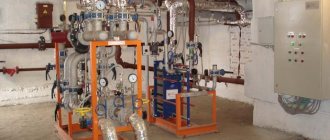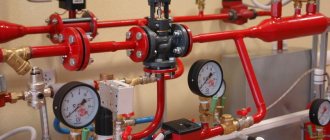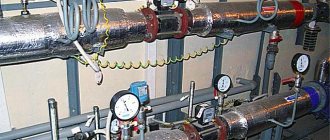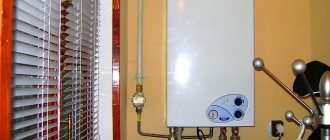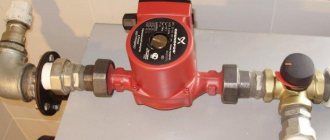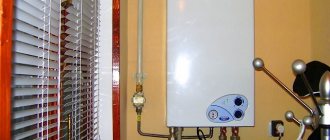Home/Heating rules/Start of the heating season
Every autumn, before the start of the heating season, residents of high-rise buildings experience discomfort because the apartments become cool. There are suspicions that utility companies are delaying the deadlines, wanting to save money. In reality, management companies cannot turn on the heating at their own discretion - there are regulations establishing the timing and procedure for this procedure. One more point: before starting the system, it needs to be tested and repaired - leaks and air locks often occur. It takes time to fix these problems so that there are no problems in winter.
Attention
The decision to turn on the heating is made by local governments, and not by the management company and TSN. The exact date has not been established; the law requires that you be guided by the weather. The heating season should begin if the average daily temperature remains below 8 degrees for 5 days. If the heat supply is delayed, residents have the right to complain to the organization servicing the house, demanding that the problem be solved and at the same time recalculated. If utility workers are inactive, you can contact the Housing Inspectorate, Rospotrebnadzor, or the district Administration.
Normative base
Relations in the field of heating residential buildings are regulated by several regulations:
- Basic Law – Federal Law No. 190 of June 27, 2010 “On Heat Supply”.
- The general rules for heat supply to residential buildings are established in Art. Chapter 7 3 Federal Law No. 416 dated December 7, 2011
- The procedure for providing utility heating services is enshrined in the Rules approved by Government Decree No. 354 of 05/06/2011.
- SANPiN 2.1.2.1002-00 specifies permissible temperatures in apartments during the cold and warm seasons.
Instructions for starting the boiler for the first time
The boiler is installed. Whether the installation work was carried out by specialists or the owner does not matter. In any case, you need to check the operation of the system. To do this, following the given tips, you need to start the heater for the first time.
- We start by checking the correct connection of the systems that are responsible for heating the water. Fidelity, reliability of connection of phase and neutral wires, presence of grounding. The functionality of the circuit breaker should also be checked. To do this, use a device - a tester or a special electrician's screwdriver.
- Next comes the search for leaks in the system . It would be useful to control the connection of underwater pipes. Presence and diagnostics of check valve operation.
- Running water into the boiler . Attention, the correct sequence of actions for the first and subsequent starts of the system will be described in the next section.
- Repeated search for water leaks in pipe installation areas b.
- Diagnostics of heater operation . Turn on the device by pressing the power button.
- Fixing the initial temperature sensor readings.
- Re-check after 15 minutes . An increase in indicators indicates the correct connection of the heating elements.
Read how to make an indirect heating boiler with your own hands here.
How to drain water from a boiler: tips, recommendations, step-by-step instructions in our article.
When do you turn on the heating?
Government Decree No. 354 sets out the conditions for the start of the heating season. There are 2 of them: first, the average daily temperature outside should drop below +8 degrees, second, this value should last 5 days. Thus, even if the temperature remains abnormally low for 4 days, but warming is promised on the fifth day, turning on the heating will most likely be postponed.
There are no specific dates in the law. However, in fact, the heating season begins in September-October, depending on the region of the country.
Ways to correctly connect the necessary heating radiators in an apartment building
If heating is carried out correctly, the house is warm and comfortable. To achieve this, you need to properly connect the radiators. There are many schemes for this action:
- parallel connection;
- diagonal;
- single-pipe;
- single-pipe with jumper;
- single-pipe bottom;
- single-pipe bottom with a jumper or tap;
- two-pipe;
- two-pipe bottom;
- two-pipe diagonally.
Despite the abundance of radiator connection schemes, in practice one-pipe and two-pipe connections are used. In order to know how to set up and then start heating in an apartment building, you need to know the advantages and disadvantages of each type. The first connection method has a number of disadvantages, although it requires less costs. The main one is the loss of heat as you travel. In this case, water is supplied vertically from the basement to all floors, enters each of the apartment’s radiators, and, when cooled, enters the same pipe. Ultimately, almost cold water reaches the top floor, causing dissatisfaction among the residents in the house.
As for the two-pipe heating system, it can be open or closed. However, in any case, the level of heat conservation is an order of magnitude higher than with a single-pipe scheme. This effect is achieved by the fact that the cooled water no longer enters the pipe, but leaves through the return channel. This keeps the order of supplying a constant temperature.
Heating turn-on progress
First of all, heating is supplied to social buildings - clinics, kindergartens, schools. Then residential buildings are connected. Heating is started gradually, the whole process is extended over 2 weeks. This is due to the inertia of the system: it is necessary to fill the pipes that supply heat to each house, and this is tons of water that requires pre-heating to a certain temperature.
Additional Information
If you suddenly turn on the heating throughout the city, the load will instantly and greatly increase. As a result, circulation will deteriorate. Unforeseen situations also often arise, despite the long-term preparation of the system. In one place a crack is found in the shut-off valve, in another - problems with the valve. In this regard, plumbers carry out a thorough check after start-up.
All about plumbing
Tips for using your heating system
Navigation
Glossary of terms
Publication rating:
Hello. Today I want to talk about some details, ignorance of which can cause many problems.
So, after completing the installation of the heating system, first of all, try to carefully examine all the mounted components, radiators, and boiler. It often happens that we missed something, or made some mistake. If we notice something, it’s better to fix it right away, don’t wait for something to happen.
Powering the system
If everything is in order, then you can start powering the system. What's the best way to do this?
In general, it is correct to feed it through the return line (a pipe that removes cooled coolant from the radiators), which is what we will do. To do this, you need to close all the valves on the radiators, then gradually add water to the system, go to the end radiators (those that are the last or farthest from the boiler), and open the valve on the return line, while simultaneously opening the Mayevsky valve (air vent from the radiator). After water flows from Mayevsky’s tap, open the radiator supply tap (of course, before closing the air vent). Next, we repeat this procedure with the next radiator, moving towards the boiler.
When all the radiators are powered, we check that the air is vented at the top point of the system (there should be a safety group, or just an air vent, depending on the type of system), then we turn on the pump, and after 5-10 minutes, we go and go through each radiator, venting the air through the vent valve (before venting the air, be sure to close the supply valve, open it after venting), and refuel the system as necessary. This will have to be repeated until there is no air left in the radiators.
TIP: to determine the presence of air in the system, you need to listen near the radiators; if there is noise or the gurgling of water, then air is still present. The airless system operates almost silently!
Starting the system
After we have made sure that the system is ventilated and there are no visual leaks anywhere, we can start starting the boiler. We light the firebox or turn on the boiler (depending on the type of boiler: solid fuel, gas, electric boiler), and maintain a low temperature, for example 40 - 45 C°
Adjusting or balancing the heating system
To properly adjust the heating system, you must do the following:
- Fully open the taps on the end radiator (or radiators if you have two or more heating circuits)
- Close the supply taps and all other radiators (leave the return open)
- Return to the penultimate radiator and open the supply tap just enough to allow heat to flow to the radiator, i.e. as little as possible
- We do the same with the remaining radiators, one by one, towards the boiler.
You may ask, why so much complexity? This method allows you to adjust even a very problematic system, that is, an incorrectly calculated one (but not any system, you can ruin the system so much that nothing will help except dismantling and reworking). Water always flows along the path of least resistance, i.e., for example, if you open the taps on the first 2-3 radiators (from the boiler) completely, then it may not reach the last ones!
Well, now in winter we will be warm and comfortable!
ADVICE:
- Don’t skimp on the essentials, as this will cost you much more in losses, for example: be sure to install two taps on the radiators (supply + return).
- Be sure to place a filter in front of the boiler or in front of the pump (you can use an ordinary oblique mesh filter). After installing the system and adjusting the radiators, the pump should run the system for at least 1 - 2 days, then clean the filter from residues in the pipes and other debris. And also before the start of each heating season, do not wait until the circulation stops and an accident occurs.
- Start the pump at maximum speed (see the instructions for the pump), after adjusting and cleaning the filter, you can switch to the minimum speed.
- You can regulate the heat transfer of radiators not only with taps (if the taps are open enough, but there is not enough heat), but also with a pump. Modern circulation pumps are mainly two or three speed. We simply disconnect the pump from the network, switch the speed, for example from 2 to 3, and turn the pump back on (this will take a few seconds), if switching under load the pump may fail.
If you have any questions, ask them on the forum, I will try to answer them.
How to find out the exact start date of the heating season?
The resolution of the district or municipal administration on approval of the heating supply schedule is published online in the public domain. This document can be found on the municipality's website. The resolution is also published in the city newspaper - the official body of local government. Other media are not required to publish the full text, but they always report information about the timing of the heating season. Until the official document is made public, it will not be possible to find out the date of heat supply even by personally contacting the heat supply organization or management company.
Adding coolant volume to the heating structure
The working medium can be ordinary distilled water and antifreeze. Filling is carried out before starting the heating system in a private house, through the make-up unit located at the lowest point. This order is very important, since trying to add liquid through other pipes located above leads to the formation of air locks.
To ensure correct startup of the radiator, check the presence and functionality of Mayevsky taps. To do this, each of them is opened.
Then a certain procedure follows:
- It is necessary to open the air and bleed valves located at the highest point of the structure.
- Next, smoothly open the tap of the make-up unit, while keeping the water pressure low so that air pockets do not occur.
- After coolant begins to flow from the pipes of both valves, they are shut off.
- Mayevsky's taps remain open until working fluid flows out of them instead of air. This point is important, since starting the heating boiler if there are air pockets can lead to damage to the entire system.
Actions if you don’t turn on the heating and it’s already cold
Attention
If the heating season has already begun, the first thing you need to do is make sure that all the batteries in the apartment are working properly. If only your home is cold, but your neighbors upstairs and downstairs are warm, the problem may be an air lock. Plumbers will quickly fix it.
The temperature in the apartment is important. According to SanPin standards, in a living room there should be at least +18 degrees, in a corner room +20 degrees. If the temperature in your home is lower, you need to call the emergency dispatch service and leave a request to solve the heating problem. Within one or two days, the cause of the malfunction must be found and eliminated, as well as notifying you about it.
You also need to demand that a representative of the management company come and record the fact that the batteries are not working and the temperature is low. The drawn up act will become the basis for recalculating the cost of heating and will serve as evidence that, if necessary, can be attached to the complaint.
Bottlings
Depending on their placement, there are two heating distribution schemes.
Lower
Bottom filling, or a heating system with bottom wiring, is used in most modern buildings. Both the feed and return bottling stations are located in the basement. The risers are connected in pairs by jumpers located in the apartment on the top floor or in the attic; at the top point of each jumper there is an air vent (Mayevsky tap).
Any riser is a bridge between bottlings. The inevitable imbalance between the risers closest to the elevator unit and those farthest from it is compensated by the difference in the permeability and size of the pipes. Let us present the usual values of remote control for a heating circuit serving the entrance to a modern ten-story building.
| Plot | DU pipes |
| Spills near the elevator unit | 50 |
| Spills at end risers | 40 |
| Risers | 20-25 |
What specific advantages does bottom routing of heating pipes provide?
- All shut-off valves on paired risers are concentrated in one place. There is no need to go up to the attic to turn it off.
- Discharging coolant into a technical basement during repairs does not pose any problems.
But: often basements are used for storage or utility rooms of stores. In this case, you yourself realize that there is no need to talk about any advantage: you will have to dump the risers through a hose into the sewer.
The main drawback of the lower wiring of heating systems is the complexity of starting them after the reset is completed. In order for circulation to begin through all risers, it is necessary to bleed off the air space. At the same time, not all residents of the upper apartments can do this; we should not forget about the empty premises.
Upper
Top filling, or heating with a top supply distribution, is completely and predictably different in that the filling supply thread is placed in the attic. The return remains in the basement. Any riser is a separate element, free from other risers.
In the attic, in addition to bottling the supply, in this case there are:
- Shut-off risers from the valve supply.
- Plugs for relieving them (more correctly, for sucking in air necessary to completely dry a group of heating devices).
- Expansion tank. Regardless of the name, it does not compensate for the increase in coolant volume during heating (the system is not autonomous, but connected to the heating main). A tank located at the top point of the filling bottling, laid with a minimum slope, helps to collect air, which is removed from there through the relief valve.
This heating system wiring scheme was widely used until approximately the 80s of the last century.
How does it look against the background of the bottom bottling?
- The main trouble here is the complexity of resetting the launch of a separate riser. To dry it completely you need:
- Close the attic valve.
- Close the valve in the basement and unscrew the plug.
- Unscrew the plug in the attic.
It’s curious: a whole house heating system with an upper supply distribution is reset and started much more easily, especially if the discharge from the heating expansion tank is routed to the elevator unit. Alas: dumping a house is associated with the loss of a huge amount of coolant, which is undesirable from the standpoint of saving thermal energy.
- The main advantage of top filling is that starting it up is extremely simple and does not depend on the residents of the house. It is enough just to slowly (so that there is no water hammer) open the house valves on the supply and return, after which all that remains is to dump the air space from the expansion tank.
When can you complain about turning on the heating late?
Nothing can be done before the official start of the heating season. The management company launches the system in accordance with the deadlines established by local authorities and has no right to violate them. If the deadline for turning on the heating has already passed, but the house is still cold, you need to call your management company or heating supply organization and ask when the heating will be turned on. If you are not given a clear answer, you should file a complaint.
Flushing the system
We fill the heating system with water to a pressure of 2 bar, then turn on the circulation pump. If there is a system of primary-secondary rings or the boiler is connected directly to the system, then you can immediately start the boiler and without heating or with minimal heating we allow the system to work for about an hour.
After this, we check the condition of the mud filter. If it is clean, the washing is considered complete. If there is dirt in it, then you need to clean the mesh, start the system again, let it run for half an hour and again check the condition of the filter. The washing is considered complete; after half an hour there will be no dirt on the filter mesh.
The flushing water must be drained from the heating system, and the residues must be removed with a compressor. After this, you can begin filling the system with working coolant.
Step-by-step instructions for filing a complaint about late heating switching on
A complaint about turning on the heating late is written in free form; there is no standardized template. Typically the document is drawn up as follows:
- In the upper right corner, the applicant indicates his personal data and the name of the organization to which the complaint is being filed. You must leave a telephone number where you can be contacted in order to resolve the issue peacefully.
- Then the problem encountered is described in detail. You should list the measures that you managed to take before filing a claim - where you applied, who you talked to. Make a list of documents attached to the complaint, if any.
- The next block lists the requirements. Write that you will go to court if measures are not taken.
- At the bottom is today's date and signature.
Attention:
The complaint about the late switching on of the heating in the apartment must be made in two copies. One is handed over personally to an authorized employee of the management company, TSN or heat supply organization, if the contract is concluded with it directly. The second copy, with a receipt mark, is kept by the applicant. If a claim is refused, you can send it by registered mail or electronically on the organization’s website.
You can file a complaint for late heating switching on here.
What to do with a stuck ball valve
If the ball valve is stuck, you can try to repair it yourself. For this:
- Unscrew the fixing nut and remove the handle. Below it is the upper part of the rod.
- If there is a hexagon clamping sleeve, you can loosen it a little.
- Using an adjustable wrench, turn the rod from side to side. Attention! You need to act slowly and smoothly. If you apply too much force or turn the key too quickly, you can deform the ball or the entire mechanism.
- Check the system. If the mechanism works normally and there are no leaks, you can install the adjusting knob. To do this, rotate it to the protrusions of the permitted degree of opening to determine whether it is possible to clamp the clamping sleeve all the way.
Important! If it is not known what material the device is made of, it is not recommended to repair it. After all, the use of additional mechanical tools can lead to its complete deformation.
To avoid damage to the ball valve, it is necessary to use only high-quality products. It is not recommended to purchase silumin devices with pipe wall thicknesses less than 2.8 mm. It is better to give preference to taps from European or Turkish manufacturers.
To prevent breakdowns, it is necessary to periodically change the position of the mechanism in order to develop the crane. It is recommended to do this at least once a month.
Considerations and possible consequences
The management company is obliged to consider the claim to turn on the heating of an apartment building within 10 days and take appropriate measures. Based on this act, it will be possible to request a recalculation of the heating payment for the entire period when there were problems with it. For each hour that the temperature does not meet the established standards, the heating fee is reduced by 0.15% of the monthly payment. Therefore, the management company is interested in quickly establishing heat supply to the house.
If the situation does not change, you should file a complaint with Rospotrebnadzor or the prosecutor's office. If departments fail to act, you can file a lawsuit with a demand to oblige the management company not only to recalculate heating fees, but also to compensate for moral damages. The court decision is executed in 95% of cases. If this does not help, the residents of the house should hold a general meeting and discuss the issue of changing the management company or organizing TSN. This will be possible if the majority of owners vote for such a decision.
Starting the boiler after inactivity
Typically, “downtime” of equipment is a period from two weeks to 2-3 months. At this time, the water heater must be completely disconnected from the electrical network and water supply. The period of inactivity is not always accompanied by complete drainage of the water from the tank and drying of the entire water supply system, however, if you know in advance that you will not use the boiler for a long time, it is better to drain the water from the tank. Then bacteria dangerous to health will not multiply inside it. The activation button on the boiler body must also be set to inactive. If the equipment is not used for a long time, microbes can accumulate inside the tank and rust can develop.
- Shut off the hot water supply pipe, otherwise the liquid heated by the boiler after startup will flow into the common pipe.
- Fill the container with cold water from the common riser, then open the heated liquid outlet tap on the boiler (red marker).
- Drain the water and wait until a steady stream appears, indicating that there is no air in the tank.
- Turn on the water heater itself using the “Power” or “On” button (depending on the model).
- Connect the equipment to the power supply system, adjust the temperature settings and perform a test heating.
If your heater model has a protection and self-diagnosis system, if there are problems, the device will notify you of them with a sound or light indication. In other cases, you need to independently check the status of the indicators on the indicator panel every 10-15 minutes until the water is completely heated in order to ensure that the equipment is fully operational.
Nuances
Although the law requires that the timing of the heating season be determined by local authorities, there are still opportunities to deviate from this norm. If the communications are in order and checked for leaks and other faults, the management company can start supplying heat without waiting 5 days with an average daily temperature of less than +8 degrees. This is also allowed based on numerous requests from residents.
There are several other important nuances associated with the start of the heating season:
- Supplying heating later than 5 days with an average daily temperature below +8 degrees is a direct violation of the legislation of the Russian Federation. For this, organizations that provide such a service face serious fines.
- If apartment owners believe that the heating is turned on too late, they have the right to enter into an agreement with the heat supply organization. You can enter the exact dates of switching on and off. Then heating will be supplied at the specified time without taking into account the outside temperature. However, it is necessary to organize a meeting of residents and ensure that the majority of residents express their consent in writing. This can be difficult to do.
- If the heating has already been turned on, but the house is still cold, you should not complain right away. The system is adjusted by increasing the pressure gradually. Therefore, it sometimes takes several days for the batteries to become hot.
- It is forbidden to unauthorizedly weld pipes or install radiators with a large number of sections to make it warmer. This allows you to make the temperature of the house more comfortable, but may disrupt the operation of the heating system. Residents of other apartments will suffer - it will become cooler for them. Therefore, after some time, the relevant services will learn about such a violation. The owner will be fined and will still be required to return the old batteries.
Comments Showing 0 of 0
Problem
The main problem that my relatives told me about was absolutely cold radiators in two adjacent rooms, while in other rooms the radiators became noticeably warmer with the start of the heating season.
- In rooms with warm radiators, the average daily temperature was +17C;
- In rooms with non-working heating +13C.
As they say, feel the difference...
For several days, calls from neighbors and relatives to the heating network ended in approximately the same way - nothing, because... the house is a cooperative one, and its maintenance is not their responsibility, except in emergency cases.
And for a cooperative of 60 apartments (4 entrances), where more than half of the residents are people of deep retirement age, it was expensive to maintain its permanent plumber out of pocket. The part-time specialist only made sure that there were no leaks during the startup of the system, and nothing more.
Searching of decisions
Having arrived at the place, the first thing I do is check the taps on the radiators and on the bypasses - everything is in the open position in both rooms. I open the Mayevsky taps on each radiator - a thin stream of water informs that there is pressure in the system and the radiator is not air-filled. But you need to find out whether there is any coolant in the system at all.
For this purpose I go to the basement of the house. From the elevator unit I determine the direction and find “my” supply and return pipes.
This is our highway.
Having reached the location of the apartments at our entrance, I see two pipes - supply and return. To the touch, both pipes differ quite noticeably, so it was not difficult to determine that the colder one was the return pipe.
In the foreground is the return line.
I use my hands again - both risers are cold, although literally a meter before this section the temperature was more than comfortable. The reason is the airing of the system on the upper fifth floor, which is why the coolant does not circulate.
I leave the basement and go to get acquainted with the neighbors on the upper floor, simultaneously inquiring from other residents about the presence of shut-off valves and their condition. As you would expect, they all have cast iron radiators installed 30 years ago.
The fifth floor is a bridge between rooms.
In Khrushchev-era houses there is no technical floor, so the coolant is supplied from below from the basement. To clarify the operation of the heating system, I propose to consider the diagram presented below.
Red arrows show the direction of movement from the supply, blue arrows indicate the return direction.
We return to the fifth floor apartment. In two rooms of a family of pensioners, cast iron radiators with 12 and 7 sections were installed. They were the ones who had to be ventilated.
The reason for the lack of heat is the accumulated air inside the radiator.
The only way available for this is using a nipple (a prototype of the Mayevsky tap) embedded in the radiator plug.
Upcoming job.
- Old galvanized bucket 12 liters;
- Pliers;
- Two flat blade screwdrivers;
- Several floor rags - splashes will be inevitable.
Here it is our simple tool.
I install a bucket under the radiator.
Since a lot of splashes are expected, I provide a place to work around the radiator - I remove the flower pots and move the furniture further away. Then I take a screwdriver and, carefully, so as not to lick the edges, unscrew the screw counterclockwise.
The effort has to be excessive.
- The old system did not work on the first try, I had to use pliers - with their help I turned the screwdriver until the screw came off the stuck place;
- The hiss of air marked the beginning of the air lock coming out. Within 3-4 minutes, the air left the radiator, after which cold water flowed in a thin stream;
- Having adjusted the screw so that the water poured into the bucket, I gave it time - in about half an hour, when the bucket was half filled, the temperature of the water changed from ice to warm, after which I screwed the screw back.
